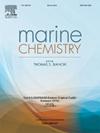Unraveling sedimentary organic matter in the Oiapoque estuarine-marine ecosystem: Insights from elemental composition and isotopic fingerprints on the Amazon coast
IF 2.5
3区 地球科学
Q2 CHEMISTRY, MULTIDISCIPLINARY
引用次数: 0
Abstract
The Oiapoque River estuary, located on the border between Brazil and French Guiana, is an understudied Amazon region characterized by intense discharge of fluvial sediment and terrestrial organic matter (OM). Influenced by environmental factors such as temperature, salinity, tides, and currents, the sedimentary OM composition reflects both autochthonous production and adjacent land biomass. This study aimed to identify and differentiate primary sources of sedimentary OM in the Amazon coastal zone using geochemical parameters such as total organic carbon (TOC), total nitrogen (TN), their relative atomic ratio (expressed as C/N), and carbon and nitrogen isotopic ratios (δ13C and δ15N). Two surface sediment sampling campaigns were conducted in 2018 during the wet and dry seasons. The sediments showed a strong correlation between TOC and TN across both campaigns (R2 = 0.98 and 0.94); however, results suggested the contribution of inorganic nitrogen forms (e.g., NH₄+). The C/N ratio indicated predominant OM from terrigenous input (∼24) at upstream sites and marine input (∼5 and ∼ 9) at downstream ones. The δ13C analysis revealed low variability along the estuary, with values around −27 ‰ upstream and near the mouth (typical of land or C3 plant contributions), intermediate values around −24 ‰ in the central portion (mixed sources), and higher values around −22 ‰ near the mouth (marine inputs). The δ15N values (∼3 ‰) were primarily found in the inner region, at the center of the estuary, and near the mouth where river discharges occur, associated with terrestrial plants. The elemental and isotopic composition of the sedimentary OM indicates a predominance of terrigenous OM, particularly near areas influenced by the Uáça and Ouanary rivers, reflecting land use and human occupation. Estuarine dynamics, influenced by rainfall and tidal currents, affect the distribution of marine inputs and the mixture of allochthonous and autochthonous sources throughout the estuary.
揭示Oiapoque河口-海洋生态系统中的沉积有机质:来自亚马逊海岸元素组成和同位素指纹的见解
Oiapoque河河口位于巴西和法属圭亚那之间的边界,是一个未被充分研究的亚马逊地区,其特点是河流沉积物和陆相有机质(OM)的大量排放。受温度、盐度、潮汐和海流等环境因素的影响,沉积物有机质组成既反映了本地生产,也反映了邻近陆地生物量。利用总有机碳(TOC)、总氮(TN)及其相对原子比(以C/N表示)、碳氮同位素比(δ13C和δ15N)等地球化学参数,对亚马孙海岸带沉积有机质的主要来源进行了识别和区分。2018年在干湿季节进行了两次地表沉积物采样活动。在两个运动中,沉积物TOC与TN具有较强的相关性(R2 = 0.98和0.94);然而,结果表明无机氮形式(如NH₄+)的贡献。C/N比值表明,上游的OM主要来自陆源输入(~ 24),下游的OM主要来自海洋输入(~ 5和~ 9)。δ13C沿河口变化较小,上游和河口附近(典型的陆地或C3植物贡献)的δ13C值在- 27‰左右,中部(混合源)的δ13C值在- 24‰左右,河口附近(海洋输入)的δ13C值在- 22‰左右。δ15N值(~ 3‰)主要分布在河口内、河口中心和河口附近,与陆生植物有关。沉积有机质的元素和同位素组成表明陆源有机质占主导地位,特别是在受Uáça和Ouanary河影响的地区附近,反映了土地利用和人类活动。受降雨和潮流影响的河口动力学影响了整个河口的海洋输入分布以及外来和本地源的混合。
本文章由计算机程序翻译,如有差异,请以英文原文为准。
求助全文
约1分钟内获得全文
求助全文
来源期刊

Marine Chemistry
化学-海洋学
CiteScore
6.00
自引率
3.30%
发文量
70
审稿时长
4.5 months
期刊介绍:
Marine Chemistry is an international medium for the publication of original studies and occasional reviews in the field of chemistry in the marine environment, with emphasis on the dynamic approach. The journal endeavours to cover all aspects, from chemical processes to theoretical and experimental work, and, by providing a central channel of communication, to speed the flow of information in this relatively new and rapidly expanding discipline.
 求助内容:
求助内容: 应助结果提醒方式:
应助结果提醒方式:


